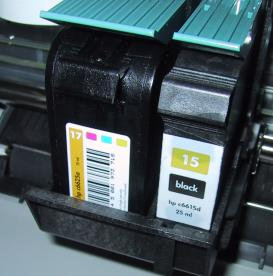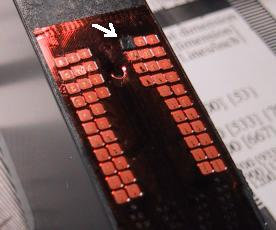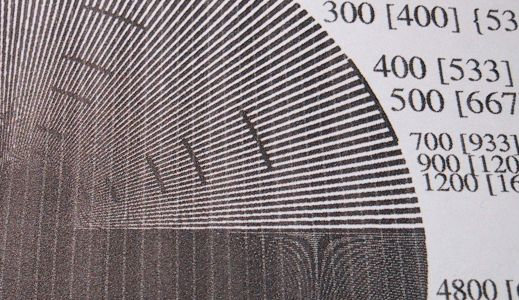
Being new to the world of ink jet printers, I did not know that an inexpensive printer usually means very expensive ink.
Many people I know have HP 6xx/7xx/8xx series printers and print photos with them. So it seemed great to get this HP 842C printer; after all it looks and works identically to the printers my brother, my friends, my colleagues and the secretary at work have (722, 812 and 880 variously).
So imagine my shock, after the printer was purchased, the UPC symbol cut out of the box for the HP mail-in rebate, the printer cartridges installed, in short, any hope of returning the printer for a refund was gone, when I discovered that this printer not only ships with half-full cartridges (as many HP printers do) but requires these half-full cartridges.
The cartridges in question are the #15 black cartridge and the #17 colour cartridge. Most other HP printers that use this type of cartridge use the #45 black cartridge and the #23 colour cartridge, which sell for approximately the same price but pack about twice as much ink!

I think this is shockingly bad ethics on HP's part. It would hurt less if these cartridges were full, but double the price. At least it wouldn't be such a waste of resources. It would hurt less if these cartridges were visibly different from the normal cartridges, or if the printer was openly marketed as being a loss-leader product.
To put things into perspective: This printer is currently sold for $165 + 15% tax here in Canada (Canadian dollars). You get a $75 HP mail-in rebate for a final cost of $165*1.15-75 = $114.75. To purchase new cartridges identical to those the printer comes with, at the prices they sell for here in town, costs $105 * 1.15 = $120.75. This is $6 more! Maybe I should go out and buy one, save the cartridges and then rip apart the printer in the interest of scientific investigation (i.e. figuring out how to spoof the #@$%er into thinking it's an 880C or at least an 812C so it will accept non-ripoff cartridges!)
Here is an actual cost comparison. I'd love to link to the relevant data on HP's web site, but the URLs for the actual products are very long and unlikely to remain valid for any length of time.
| Printer Type | Cartridge Type | Best Price | Capacity | Ink Cost | Cost multiplier |
|---|---|---|---|---|---|
| Regular | #45 Black | 2 for $53 | 42ml | $0.63/ml | 1.00 |
| #23 Colour | 2 for $53 | 30ml | $0.88/ml | 1.00 | |
| Rip-Off | #15 Black | $30 | 25ml | $1.20/ml | 1.90 |
| #17 Colour | $33 | 15ml | $2.20/ml | 2.50 |
It costs me 2.5 times as much to print a photo as it costs everyone else with practically identical non-ripoff printers!
I don't think I'll be printing very many photos.
Since the 842C is, visibly, exactly the same printer as the other 800 series printers, I thought perhaps the regular cartridges could be made to work. Some searching on the net unearthed this article which suggested that, indeed, one could use the regular non-ripoff black cartridge by simply taping over one contact. I was able to test this with a borrowed #45 cartridge:

Sure enough, the printer accepted the cartridge with this contact taped over. I tried some printouts (using the HP supplied Linux driver in "draft" mode) and saw nothing wrong. However running the self test revealed that taping over this contact not only spoofed the cartridge type detection, but also disabled some of the ink nozzles:

At first I thought perhaps the cartridge had blocked nozzles, as it was old and not too clean. However I have since been able to test with a different, clean #45 cartridge and obtained exactly the same pattern.
I tried individually covering every contact in the top two rows. I found that covering the top left contact also made the cartridge work, with a different set of ink nozzles disabled...

The other 10 attempts all resulted in the printer not accepting the cartridge. I did not experiment further.
How acceptable is the printer in this mode? Judge for yourself from this section of a Postscript resolution test page. The missing ink jets show up very clearly in this pattern. However in normal text they don't seem to matter much.

I also got my hands on a #23 colour cartridge. It has far more contact points than the #17 cartridge (though they all correspond to contact pins in the 842C printer). I tried taping over all the contact points that have no counterpart on the #17, and then removing the tape bits at a time. Hardly a scientific test, but the printer rejected the cartridge in all attempts.
The conclusion is that I can obtain low-quality draft text printing at the same per-page cost as with other HP printers, but for high-quality output of any kind, I'm stuck with their overpriced 'special' cartridges.
I hope this has been informative and can help you decide whether this printer is good for you. And though the 842C is currently on closeout sale, and will soon be irrelevant, do not forget that with a bit of internet research, you can determine the per-milliliter and approximate per-page cost for any printer. A "bargain" printer may be a great bargain indeed if you plan to use it only very rarely, or it may end up much more expensive than a printer that costs $150 more. The "free" printer included with a computer system purchase may be more cost effective to throw in the garbage (after you've used up the ink it came with) than to continue buying ink for.
Anyone who wants to supply me with technical data on HP printers that would allow me to hack mine to accept the #23 cartridge, please do so!
Newer HP printers (9xx series and PhotoSmart 1xxx series) use a newer type of colour cartridge (#78) with double the resolution. It is available with 19ml of ink for the "regular" price and with the full 38ml (the cartridge's physical capacity) for a higher price. Most of the newer printers use the #45 black cartridge, although there is at least one 9xx series printer that uses the #15.
Caveat Emptor!
All information on this page is current as of January 10, 2002.